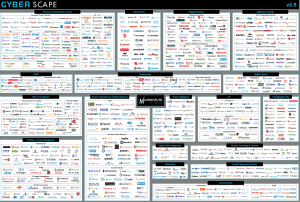6 Best Practices for Evaluating Cybersecurity Tools
Posted by: Ernest Dunn
A question we regularly hear from our clients is “How can I be sure my tools are working to protect my sensitive data?” Most of our clients are continually evaluating their security architecture to help protect their business from modern threats. As the threat landscape continues to evolve, so does the vendor space. There is an ever-evolving list of security technology manufacturers out there. The CyberScape is one mapping of this:
New vendors pop up almost daily, and existing platform providers continue to release new products and features. Keeping up with the vendor and tool landscape can feel like a never-ending research project for security teams. And while checking out new tech is fun and educational, it can put a strain on security teams that are already overwhelmed with day-to-day operations and engineering. This is a real challenge for many organizations as they want to ensure they get the right tools that will help mitigate risk, integrate seamlessly into the environment, and fit within the budget. Some security domains, such as our endpoint and cloud security services, have dozens of players. Having a sound strategy for testing can help streamline the evaluation process. At GuidePoint, we do a lot of this for our clients, and below are some best practices and lessons learned:
- Take a risk-based approach. As you evaluate tools, take a step back and ask yourself if the control being evaluated will truly help your organization reduce risk. If it doesn’t, then your time and budget may be better spent elsewhere. While this is not a rule that is set in stone, it is a good one to review as you start your evaluation.
- Define your requirements. You would be surprised how many times this does not happen. Take an hour and map out your high-level requirements for an optimal solution to meet your use cases. Make sure to classify any “must-have” vs. “nice to have” features. Also, be sure you align whatever technology you’re evaluating into how it fits within and integrates into your current tech stack, as well as what your team can actually support. Keep in mind any involvement needed from server teams, network teams, helpdesk, etc.—not just the security team. This exercise can quickly help you eliminate non-qualified solutions from your shortlist. And the less time you spend on vendor demos, the faster you can get to actual solution testing.
- Have a test plan. This is something else that is missed many times. If you do not have a documented test plan, it is difficult to truly compare solutions. Most vendors have POC evaluation criteria that can be leveraged as a starting point, and solution providers like GuidePoint Security can share additional examples. As part of this process, you’ll want to follow a consistent methodology so that you can quickly score solutions side by side.
- Limit the scope. Defining requirements should help you limit the number of solutions you test. We have seen clients test 7-8 solutions at times and while this may work for larger enterprise clients with innovation centers and extensive lab environments, many times there are diminishing returns for the more solutions tested. As a rule of thumb, we generally recommend that clients perform deep dive testing of no more than 2-3 solutions after a detailed requirements review.
- Leverage your resources. Find and use existing comparison documents where possible to speed up this effort. Analyst reports can help here, but they aren’t bulletproof. Work with your partners and industry peers to see what they have on hand. No need to recreate the wheel. Also, push vendors to do deep dive demos tailored to your use cases rather than unnecessary POCs.
- Pilots are better than POCs. Where possible, test in controlled, isolated areas of production rather than solely in a lab. Lab POC testing is fine, but many times this limits the amount of actual integrations you can test, such as Active Directory Integration, SIEM, architecture integration, etc. Again, control and isolation are the key phrases when testing in production. Don’t take your network down testing a new tool.
Integration with Cybersecurity Frameworks and Standards
Cybersecurity tools play a crucial role in helping organizations align with and support compliance with various frameworks and standards such as NIST, ISO 27001, and GDPR. These tools provide the necessary capabilities to implement and manage security measures that are prescribed by these standards.
For instance, cybersecurity tools can automate the process of monitoring and logging access to sensitive data, which is a requirement under all three frameworks. They also assist in risk assessment and management, helping organizations identify vulnerabilities and apply the appropriate controls as recommended by NIST and ISO 27001. Furthermore, tools like data protection and encryption software are vital for complying with GDPR’s strict privacy regulations, ensuring that personal data is securely processed and stored.
Overall, the integration of these tools into an organization’s cybersecurity strategy is essential for maintaining compliance and enhancing the overall security posture.
Many of these recommendations seem like common sense, but they are worth restating as clients regularly struggle with testing tools. At GuidePoint Security, we help our clients evaluate security solutions daily. We work with over 400 cybersecurity manufacturers to bring the right solutions to our clients to reduce risk and protect their businesses. Our goal is to help our clients build and evolve their security programs. Let us know if we can help.
Ernest Dunn
Regional Partner, Mid-Atlantic,
GuidePoint Security
